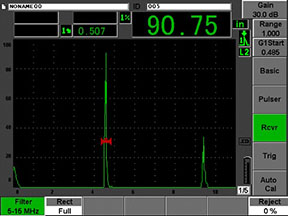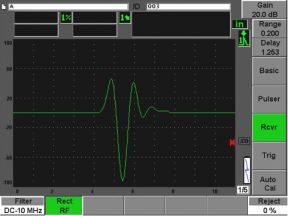3.4 脉冲发生器和接收器的操作
All ultrasonic flaw detectors have a number of selectable parameters that are used to optimize the pulser and receiver sections of the instrument setup for a given test.
Typical Pulser Controls

Pulse Type: Two types of excitation pulses are commonly used in portable flaw detectors. A spike pulser generates a broadband pulse with a very fast rise time and an exponential recovery. A square wave pulser generates a single cycle square wave that is tuned to the center frequency of the transducer. Square wave pulsers generally offer greater energy output from a given transducer and are now commonly available.
Pulse width or frequency: As noted above, a square wave pulse must be tuned to the frequency of the transducer. (Spike pulses are broadbanded and do not need to be tuned.)
Pulse energy or voltage: The amplitude of both spike and square wave pulses may be adjusted for optimum response over typical ranges from 100v to 400v or greater. Higher voltage maximizes penetration, while lower voltages improve near surface resolution and conserve battery life.
Pulse repetition frequency (PRF): This controls the rate at which the pulser fires, typically at rates from 10 Hz to 1000 Hz or greater. A high PRF permits faster scanning and data acquisition, while a low PRF conserves battery life and also limits wraparound noise when working with very long sound paths.
Damping: The damping control selects a resistor that modifies the shape of the outgoing waveform. Standard values are between 50 ohms and 500 ohms. Lower damping resistance increases pulse damping and improves near surface resolution, while higher damping resistance reduces damping and improves penetration.
Test Mode: Available modes are pulse/echo, dual, and through transmission. Pulse/echo mode is the most common setup, using a transducer in which a single element acts as both transmitter and receiver. Dual mode is used with dual element transducers, where a single transducer assembly contains separate transmitter and receiver elements. Through mode is used for setups where two separate transducers are used on opposite sides of the test piece.
Typical Receiver Controls

Gain: All flaw detectors provide adjustable receiver gain over a broad dynamic range (typically 100 dB or more) to account for the wide variation in received signal amplitude among typical tests. Gain adjustment may be divided into base gain and reference gain settings to accommodate certain code requirements. Digital instruments also allow the operator to adjust gain with respect to distance or depth (Time Varied Gain or Distance Amplitude Correction). These functions are discussed in Section 6.
Filtering: Selectable bandpass filtering of the received echoes can often improve signal-to-noise or near surface resolution by filtering out unwanted high or low frequency components of the signal. Many instruments provide a broadband setting and a number of choices for narrowband filtering across the total frequency range.
Rectification: Received echoes can be displayed either as an unrectified RF signal, as half wave positive or half wave negative rectified signals, or with full wave rectification. Raw echoes are initially processed as RF waveforms with both positive and negative peaks. The RF display mode is useful when working with very thin test pieces and in cases where echo phase or polarity is of interest. Half wave positive rectification shows only the positive peaks, while half wave negative rectification shows only the negative peaks, flipped to the positive side of the baseline. Half wave rectification can in some cases improve signal-to-noise by reducing spurious peaks. Full wave rectification displays both positive and negative echo lobes together on the positive side of the baseline and is the most commonly used format in flaw detection applications.



